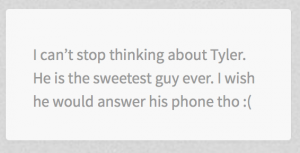Week 9 – Gambarato
This week on our Wednesday class, Neeve and myself continued to develop the relationship between Miranda and Tyler on Facebook chat, to build the believability of the conversations and add context to the budding relationship between the two of them. Prior to this meeting, I had been adding posts to Miranda’s Tumblr, www.m1randa-merma1d.tumblr.com, to show her reflecting on her break-up experience and also commenting on this “new guy” (Tyler) that she was interested in. While I was doing this, Neeve had been working on the ways in which she can construct voicemail messages and images that show the missing person case is in the past, rather than what we had originally discussed which was making everything present tense. Displaying it in a past-tense will allow us to explore more ways in which “the Williamsville police” have discovered information about her disappearance.
Our “homework” for this week is as follows; Neeve will be taking pictures of the “crime scene” where blood is found, and also the two phones belonging to both Miranda and Tyler. While I on the other hand have the much easier task of just creating more “reflective” Tumblr posts on the new man in Miranda’s life.
This weeks reading was as Dan said, one of the more complex readings. I found myself getting lost while reading it in class so I decided to take it home and read. Two key terms I learnt were the “cultural attractor” and cultural activator”. The cultural activator in Dodging the Bullet is the ability for the audience to navigate through the Williamsville blog, and uncover various elements of the missing person case. Whilst, the cultural attractors are the ability for people to feel included in the missing person case, and feel that they are as much a part of the investigation as the police themselves. We also hope to create empathy towards Miranda. Finally, we have decided that our story is a closed transmedia story as there is a limit to the amount of navigation of the blog and alteration of the final outcome. Despite Neeve and I never knowing nor saying what really happened to Miranda, we are leaving this unsaid, and therefore closed.





